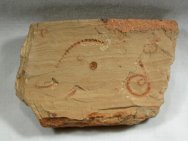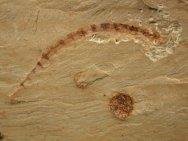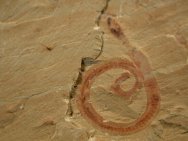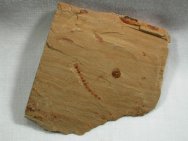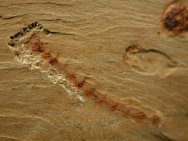| Name:
Lobopodia, Cardiodictyon catenulum & Nematomorpha, Maotianshania cylindrica
Geological
Time: Early Cambrian (~525 million years ago)
Size (25.4mm=1
inch): Size: mm (25.4mm=1 inch) Cardiodictyon: 30 mm long Maotianshania:
35 mm on a 45 mm by 75 mm matrix and 21 mm long on a 50 mm by 50 mm matrix
Fossil
Site: Chengjiang Maotianshan Shales, Quiongzhusi Section, Yu’anshan
Member, Heilinpu Formation, Jianshan, Anning, Yunnan Province, China
| 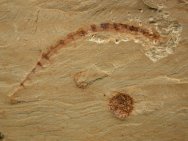 Description:
The discovery of the Chengjiang Biota by Hou Xian-guang in 1984
resulted in a clear window on what is known as the Cambrian Explosion.
The diversity of soft-tissue fossils is astonishing: algae, medusiforms,
sponges, priapulids, annelid-like worms, echinoderms, arthropods
(including trilobites), hemichordates, chordates, and the first
agnathan fish make up just a small fraction of the total. Numerous
problematic forms are known as well, some of which may have represented
failed attempts at diversity that did not persist to the present
day. Description:
The discovery of the Chengjiang Biota by Hou Xian-guang in 1984
resulted in a clear window on what is known as the Cambrian Explosion.
The diversity of soft-tissue fossils is astonishing: algae, medusiforms,
sponges, priapulids, annelid-like worms, echinoderms, arthropods
(including trilobites), hemichordates, chordates, and the first
agnathan fish make up just a small fraction of the total. Numerous
problematic forms are known as well, some of which may have represented
failed attempts at diversity that did not persist to the present
day.
The
Lobopodians are small marine and terrestrial animals termed colloquially
“velvet 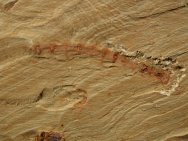 worms”
or “worms with legs”. While all Recent forms are terrestrial,
most fossil Lobopodians are marine, and are known primarily from
the Cambrian. Six named genera, each with a single species, are
known from the Chengjiang Biota, making it the richest source of
fossils of the type on Earth. This is one of the most striking,
and quite rare; as of 2004, well less than 100 examples were known.
A large specimen was thought to be 20 mm, so this one is abnormally
large. A complete example worms”
or “worms with legs”. While all Recent forms are terrestrial,
most fossil Lobopodians are marine, and are known primarily from
the Cambrian. Six named genera, each with a single species, are
known from the Chengjiang Biota, making it the richest source of
fossils of the type on Earth. This is one of the most striking,
and quite rare; as of 2004, well less than 100 examples were known.
A large specimen was thought to be 20 mm, so this one is abnormally
large. A complete example 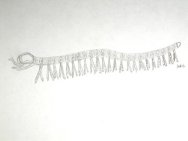 possesses
23 – 25 angular sclerotized paired sclerites, each pair of
which is associated with a pair of legs. Each leg bears curved claws
which are thought to have served the creature as an adaptation to
crawling on other organisms. It is most closely related to Aysheaia
from the younger Burgess Shale, and is unknown outside of Yunnan
Province. This fine example has incredible detail, with the “myriapod”-
like legs in clear evidence. The head is clearly seen on the counterpart
example. Notice too the fine complete and partial worms present.
This is Maotianshania cylindrica, a member of the Nematomorpha.
The species is known from numerous specimens, many of which have
preserved details, with the taxon named after, Maotianshan (Mao
Tian Hill), site of the discovery of the Chengjiang Biota by Hou
Xian-guang in 1984. The intestine is often preserved as a dark film,
indicative of its deposit-feeding lifestyle. possesses
23 – 25 angular sclerotized paired sclerites, each pair of
which is associated with a pair of legs. Each leg bears curved claws
which are thought to have served the creature as an adaptation to
crawling on other organisms. It is most closely related to Aysheaia
from the younger Burgess Shale, and is unknown outside of Yunnan
Province. This fine example has incredible detail, with the “myriapod”-
like legs in clear evidence. The head is clearly seen on the counterpart
example. Notice too the fine complete and partial worms present.
This is Maotianshania cylindrica, a member of the Nematomorpha.
The species is known from numerous specimens, many of which have
preserved details, with the taxon named after, Maotianshan (Mao
Tian Hill), site of the discovery of the Chengjiang Biota by Hou
Xian-guang in 1984. The intestine is often preserved as a dark film,
indicative of its deposit-feeding lifestyle.
|
|




